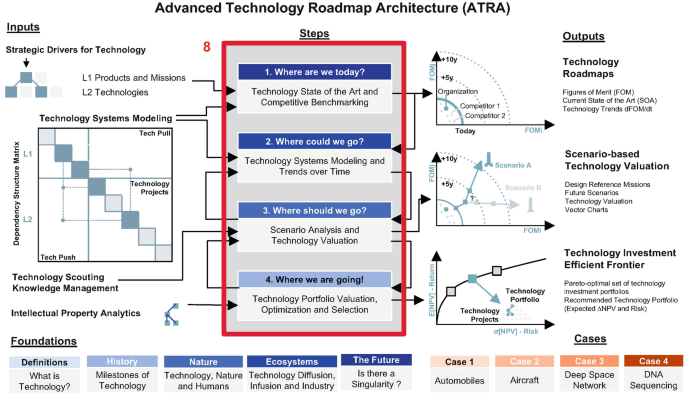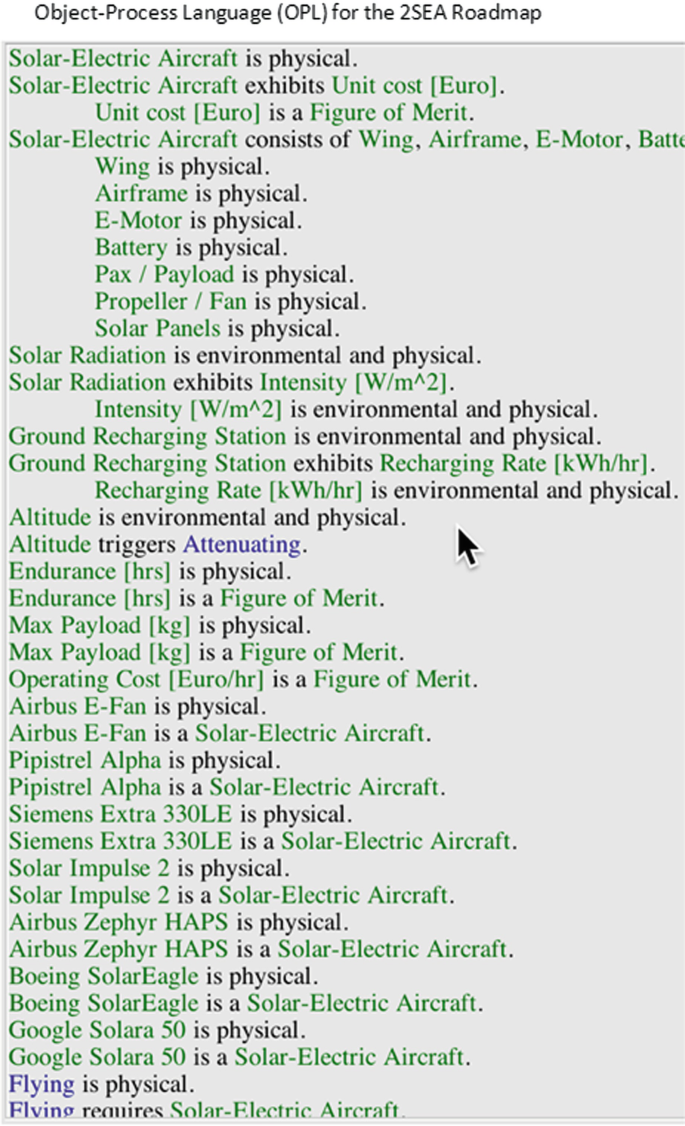Abstract
This chapter begins by explaining what a technology roadmap is and why it is important in helping organizations plan for the future. We also discuss briefly the history of technology roadmapping (Kerr and Phaal, Technol Forecast Soc Chang 155:119967, 2020) as well as provide an example of a reference technology roadmap. This roadmap is designated as “2SEA” and concerns the development and deployment of solar electric aircraft. We give examples of organizations, such as NASA, that rely extensively on technology roadmapping and provide a normative approach to roadmapping called the advanced technology roadmap architecture (ATRA). Finally, we provide a scale for technology roadmapping that organizations can use to assess their own capabilities and maturity level in terms of technology roadmapping. This approach was implemented at a major aerospace company, with significant impact on the composition and direction of their R&D portfolio, and has since been adopted by others in industry, government, and academia.

Access this chapter
Tax calculation will be finalised at checkout
Purchases are for personal use only
Notes
- 1.
I served as Senior Vice President (SVP) of Technology Planning and Roadmapping at Airbus for 2 years (2017 and 2018) while on leave from MIT and reported to the Chief Technology Officer (CTO). The CTO at Airbus is at the Executive Vice President (EVP) level and is a member of the company’s senior executive management team (the so-called “C-Suite”).
- 2.
We estimate that it takes about $250 K per year (2019 figures) to create and properly maintain a quality technology roadmap. This means that an organization that has about 20 technology roadmaps should plan to spend about $5 million per year on technology roadmapping.
- 3.
These 12 elements are a general recommendation for the outline and content of a technology roadmap. In our technology roadmapping and development class at MIT, we follow this outline and add between 15 and 20 technology roadmaps per year, see http://roadmaps.mit.edu
- 4.
CFRP = carbon fiber reinforced polymers.
- 5.
OPD and OPL are based on ISO Standard 19,450 (2015) for object-process methodology (OPM).
- 6.
In general, physics-based models are preferred since empirically derived models are only valid over the interval of training data that were used on the input side. As technology progresses, the correlations derived for the empirical models may no longer be valid.
- 7.
Disclaimer: While we have used the Zephyr as a motivating example at the beginning of this section, the strategic drivers in this section should not be taken as a direct reflection of the Airbus Defense and Space business strategy in the area of solar electric aircraft.
- 8.
Not all targets or ambitions stated in a technology roadmap may initially be funded or fundable by the R&D budget. That is fundamentally okay, since the technology roadmap is a statement of ambitions, translated to quantified targets. However, once converged, the technology roadmap targets should be achievable both fiscally and in terms of their feasibility within physical limits.
- 9.
This project was partially funded by the DARPA Vulture program whose aim it was to develop a solar-powered UAV that could fly for 5 years without landing. The project was canceled in 2012.
- 10.
In many organizations, R&D projects are selected based mainly on “intuition” alone and the voices of a few – usually senior and very experienced – individuals. This is potentially a dangerous way to go as Christensen shows (Chap. 7) due to the innovator’s dilemma. Usually this intuition-based process by entrenched senior engineers and executives will favor sustaining incremental technology investments, instead of sustaining radical or even disruptive ones. The dynamics and pitfalls of R&D project selection and R&D portfolio management are discussed further in Chap. 16.
- 11.
NASA has recently selected the ATRA framework for researching improved ways of managing its technology portfolio, see: https://www.nasa.gov/directorates/spacetech/strg/early-stage-innovations-esi/esi2020/astra/
References
Bernal, Luis, et al. "Technology roadmapping handbook." International SEPT Program, University of Leipzig (2009)
Kerr C, Phaal R. Technology roadmapping: Industrial roots, forgotten history and unknown origins. Technological Forecasting and Social Change. 2020 Jun 1;155:119967.
Knoll, Dominik, Alessandro Golkar, and Olivier de Weck. "A concurrent design approach for model-based technology roadmapping." In 2018 Annual IEEE International Systems Conference (SysCon), pp. 1-6. IEEE, 2018.
NASA Technology Roadmaps, Office of the Chief Technologist (OCT): https://www.nasa.gov/offices/oct/home/roadmaps/index.html
Phaal, Robert, and Muller, Gerrit, “An architectural framework for roadmapping: Towards visual strategy,” Technological Forecasting and Social Change, Volume 76, Issue 1, 2009,Pages 39-49, ISSN 0040-1625
Schimpf, Sven, and Thomas Abele. "How German Companies apply Roadmapping: Evidence from an Empirical Study." Journal of Engineering and Technology Management, 52 (2019): 74-88.
Author information
Authors and Affiliations
Appendix
Appendix

Object-process language (OPL) for the 2SEA roadmap
Rights and permissions
Copyright information
© 2022 Springer Nature Switzerland AG
About this chapter
Cite this chapter
de Weck, O.L. (2022). Technology Roadmapping. In: Technology Roadmapping and Development . Springer, Cham. https://doi.org/10.1007/978-3-030-88346-1_8
Download citation
DOI: https://doi.org/10.1007/978-3-030-88346-1_8
Published:
Publisher Name: Springer, Cham
Print ISBN: 978-3-030-88345-4
Online ISBN: 978-3-030-88346-1
eBook Packages: EngineeringEngineering (R0)

